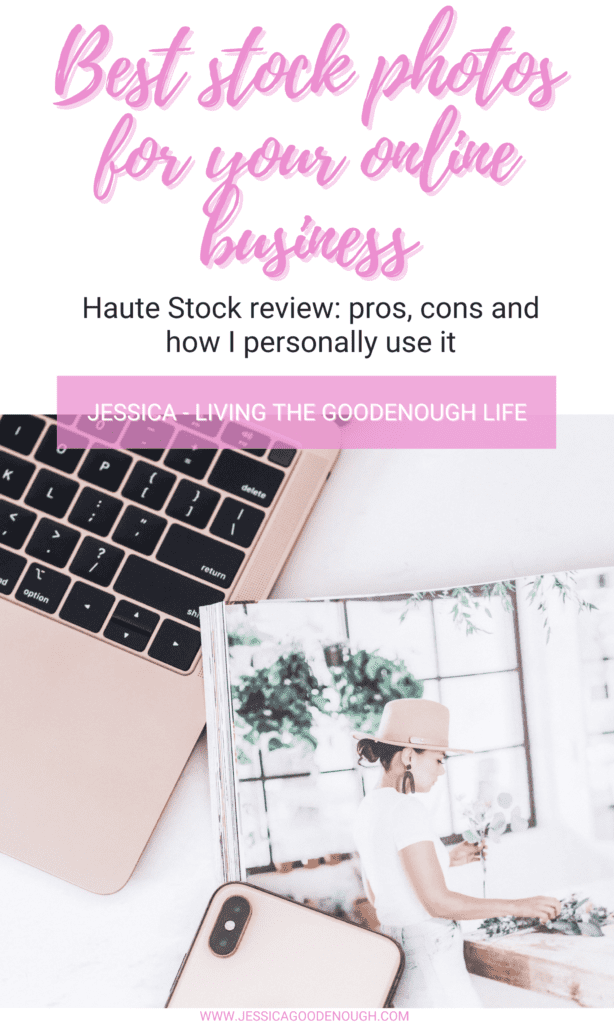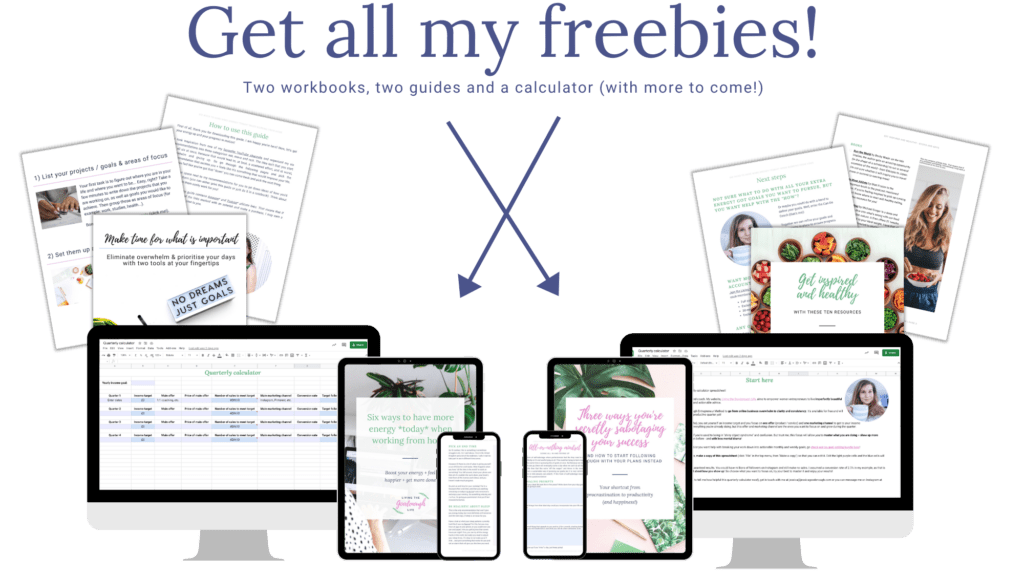Hello! Today I’m sharing about a tool that I love using in my business: Haute Stock*! I’ll be covering why I recommend using stock photos and Canva templates in your business, as well as the pros and cons of Haute Stock + how I personally use it.
(Note: this post contains affiliate links. If you click a link marked with an asterisk or one of the buttons, I may earn a commission at no cost to you. I only recommend products that I love. Thank you for supporting me and my work!)

Why use stock photos and Canva templates in your business?
Stock photos
We live in a very visual world. Long gone are the days of spending time reading and commenting on blog posts with no photos / only one crappy image. If you check any social media platform on your smartphone, you’ll see a lot of photos and videos. (You can find my podcast episode about getting comfortable showing up on video here and below, then back to images!)
For better or for worse, it’s all about scrolling now and beautiful visuals can “stop the scroll” and attract your ideal customer to look into more of your content. But unless you’re a style influencer or a food blogger sharing your own photos / outfits, you don’t need to generate all your photos yourself!
I think it’s important to show your face online to create a connection with your audience. But on the other hand, an Instagram feed of only selfies would be a bit overkill. Enter stock photos! They allow you to share images in-line with your brand (more on that later), without having to spend a lot of time taking the photos yourself. I’m all about reducing friction to show up consistently online. If you’re struggling with this, a good question to ask yourself would be “what would this look like if it was easy?”.
Canva templates
In the same vein, Canva templates can save you a lot of time. Canva* is a free online tool (with a premium version available too) that can help you with all your graphic design needs, from social media posts to presentations. Within Canva, there are quite a few editable templates for Pinterest pins, Instagram Stories and much more. Websites such as Haute Stock* also offer template collections that look cohesive, which can be imported to Canva with the click of a button.
Whichever you choose to use (the free ones already in Canva or a paid option), they can save you a lot of time. Instead of starting from scratch (and possibly feeling a bit overwhelmed by the “blank slate” in front of you) , all you need to do is update the photos, fonts and colours to be in line with your brand. For example:
So the short answer to why use stock photos and Canva templates is: they will help you look professional, while saving you time!
So, what is Haute Stock?
I went to the source to define Haute Stock*: their own website! They define themselves as “the premium visual content membership for women entrepreneurs”. Haute Stock offers “stock photos & design assets to help you simplify your visual content creation”. And this is what they say about their mission:
We help women-owned businesses and brands save time, stress less, and sell online using our carefully curated stock photos, customizable templates, designer branding elements, and monthly marketing guides!
I’ll get to my opinion of Haute Stock in a minute, but if we stick to what is on their website, their members-online library offers:
- Curated stock photos in a variety of colourways and categories;
- Marketing templates that can be customised to match your brand;
- Social media graphics: done-for-you engagement boosting quotes;
- Branding elements: icons, frames, arrows, brush strokes and more (I have yet to use these);
- Monthly bonuses: content calendar & marketing guides to help you grow.
This video is actually a couple years old (so there are quite a few more photos in the library now!), but it gives you a good idea of what Haute Stock looks like “on the inside”:
Pros of Haute Stock
- Beautiful feminine photos, that don’t look like typical “stock photos” (you know what I mean!).
- A very searchable library: I love love love that I can filter the photos by colour to match my brand colours and that I can also filter by orientation (e.g. if I want a square photo or a tall one). You can also search for keywords to get something specific or browse through their categories (e.g. motherhood, workspace, health & wellness, etc.).
- Diverse models in the photos. I like that the photos feature women of all colours and sizes. This would be particularly helpful if your brand targeted a specific demographic or if diversity was one of your core values. You can even search the photos by skin colour, if you wanted for example to write a feature on black business owners and needed a cover image for the blog post, like the one below:

- Cohesive template “packs”: I’ll talk more about Instagram and Pinterest below, but Haute Stock doesn’t just provide me with photos. I can also download template packs to quickly create pins, Instagram quote or testimonial posts.
- Monthly caption guides: I have access to a whole month’s worth of post ideas in one easy-to-reference guide. As I mentioned in my podcast episode about creating video content, these kind of prompts can be very helpful in avoiding the “blank slate” feeling when creating content.
- Bonus content marketing guides: on top of the caption guides, every month Haute Stock members get access to a “how to” guide. Past guides have included: “How to Audit & Optimize Your Instagram Account”, “How to Create Captions & Images that Connect With Your Audience” and “Mastering Reels”. If you joined now*, you’d have access to April’s guide on “How To Create An Instagram Hashtag Strategy For Your Business”. You can also find free tips on their blog:
Cons of Haute Stock
- Not being able to use their photos in paid products. I use Haute Stock photos in my freebies (check them out here!), but their image licence prohibits us from using their images in products that are for sale. I very much understand that they don’t want people reselling their photos, as selling photos is essentially the core of their business! But it would be nice to use for example their journaling images in my workbooks, like my goal-setting bundle or my journaling prompts for when you feel unmotivated / discouraged (where images aren’t the main focus).
- The tech mockups could be improved. This is a very minor point, but the Canva mockups that came with some courses I enrolled in (e.g. Printables by Number*) include “frames”, which means that I can simply drag and drop my images and tadaaa they’ll be in the exact right place on the screen. There is a workaround with Haute Stock tech mockups (see below), but it would be nice to have these frames included.
How I use their photos + templates in my business
For Instagram
As I mentioned earlier, I’m all about reducing friction to showing up consistently online. So, as part of that, I use Haute Stock photos + Canva templates for my Instagram. As you can see, I alternate between photos and then quotes / announcements in my brand colours. Within the photos, I share a combination of my own photos – to show a bit of personality and give a “behind-the-scenes” peek to my followers – and Haute Stock photos, for a more aspirational vibe. Using stock photos along with pictures you’ve taken yourself can help you achieve that balance between relatable and inspirational content.
I like my Instagram feed to look cohesive (though this is all work in progress of course), so I edit my photos and the Haute Stock images in the same way. I import them to the free Lightroom app and use a preset that I created (tell me in the comments if you’d be interested in learning more about that!). So all my photos – whether I took them or one of the Haute Stock photographers took them – have a bright, rosy and cool look. I plan my Instagram feed (and my Pinterest pins) out using Planoly* (but more on that in a later blog post!).
I’m actually going to dig deeper into the Haute Stock caption guides soon and work on making my feed reflect how I can help people + who my ideal client is better. So depending on when you’re reading this, my Instagram feed might reflect my “content pillars” (goals + mindset, entrepreneur lifestyle and business growth + impact) better, using Haute Stock images:
For my blog / Pinterest
On my blog, I use Haute Stock photos for the cover photos, for example in this very blog post, which is a bit meta! I also use them for the pinnable image at the top of the post. Being able to filter photos by orientation (square in these two cases) is especially helpful. For those photos, I will also use my Lightroom preset so that my blog visuals looks cohesive.
I also use Haute Stock photos and Canva templates to create pins in order to promote my blog posts, podcast episodes, freebies and paid products (you can get all the latest of each of those here!) on Pinterest. Having the Canva template “packs” + using the search function within the Haute Stock photo library makes this a super speedy process.
As you may know, Pinterest is now favouring “fresh pins”, i.e. it’s better to create several pins with different images (that can all still link to the same piece of content), than to reshare the same pin over and over again.
So, to create these “fresh pins”, I start with one of their Pinterest template packs in Canva*. I’ll update the fonts and colours to match my brand and then I’ll search the Haute Stock* library for relevant images (which is one of my favourite pastimes, I actually need to stop myself from scrolling through their photos haha). I don’t edit these in Lightroom as people don’t look at my Pinterest profile like they would my Instagram feed, so it doesn’t matter as much if they’re not all edited the same.
Then, the next time I want to create pins for a different blog post / podcast episode, I can just make a copy of that “design” in Canva and tadaaa I don’t even need to change the colours and fonts, just the text and images. Massive time saver! You can see all my pins here: they might not be perfect, but they do look professional and “on brand”.
Back to you
Do you use Haute Stock*? Or any other kind of stock photography? What other tools would you like me to review? Share in the comments below!
![Only a month late... Here are our Valentine's Day photos! 👩🏼❤️💋👨🏻😅
We've been on a bit of a Caribbean kick (say that 10 times!) since watching the One Love film about Bob Marley on Valentine's Day + @gazoakley's adventures in Jamaica on the YouTubezz. 🇯🇲
So far we've eaten at @turtlebayuk [apologies for the blurry photos, I took them before getting my new @fairphone!] and ordered from Pappy's Afro Caribbean Takeaway (don't think they're on Instagram)... Next step is to make it at home; any recipe recommendations? 😘
#PlantBased #JamaicanFood #CaribbeanFood #OneLove](https://jessicagoodenough.com/wp-content/plugins/instagram-feed/img/placeholder.png)




It’s possible that their license has changed, but they don’t prohibit use in commercial products such as workbooks if the images aren’t the primary focus.